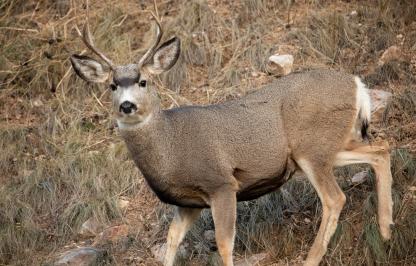Wyoming Game and Fish Department researchers are once again venturing into Wyoming’s remote landscapes in search of the rarely-sighted wolverine.
In Wyoming, wolverine habitat occurs at high elevations, often in designated wilderness. This rugged terrain can be challenging to access in winter. However, a team of biologists is taking on the challenge and placing trail cameras and wire brushes in hopes of catching a glimpse of wolverines throughout the state’s western mountains and the Bighorn and Snowy Range Mountains. Trail cameras provide data on wolverine presence while wire brushes are designed to snag a few hairs from passing animals that can be used for DNA analysis.
Wolverines live in habitats with limited amounts of food so individual animals require hundreds of square miles to live and reproduce. This means the number of animals living in a given area is extremely low.
This project was run previously for two consecutive winters beginning 2015/16. During those winters at least 6 unique wolverines were detected over the 51 monitoring areas. In those years the project was focused on gathering basic information about population distribution and occupied range in the state.
“This work added significantly to our knowledge of wolverine distribution in the state. We documented individuals in the Wind River and Absaroka Mountains, but interestingly not in Yellowstone National Park or the Wyoming, Salt, or Teton Mountains where they have also been documented historically,” said Nongame Supervisor Zack Walker.
Walker continues, “However, DNA results from wolverine hair samples in these two previous winters revealed two unique females outside of the current predicted breeding distribution area. This might indicate an expansion of wolverine within the state. We hope that during the current monitoring effort we will see additional individuals in these areas or possible signs of reproduction”
Now, five years later, the project is looking to compare wolverine occupancy between the survey periods. Monitoring sites will remain active into April as females begin ranging farther from their den sites, but project biologists have already begun to detect wolverines this winter.
Collaborators on the project include Eastern Shoshone, and Northern Arapaho Tribes, US Fish and Wildlife Service, and the US Forest Service. You can help by reporting wolverine sightings here.
Caption for top photo: In late 2021 a wolverine visits one of the lure stations and is captured on camera.Camera trap stations use a combination of lure and bait to attract wolverines to the camera
station, plus wire brushes (gun brushes) to collect hair from the wolverine when the individual climbs up to the bait.
For stations that are revisted throughout the winter, the lure, a combination of pungent ingredients like beaver castor, fish oil, and skunk quill, is soaked into a sponge and hung above a bait consisting of skinned deer quarters. Both are installed some 8-10 ft above the ground level to preferentially attract scavengers adapted to climbing to find meat.
Here, Game and Fish Wolverine Technician Colin Cikoski is placing the lure sponge above the bait, above a collar (the white band) in which wire brushes are installed to collect hair from any animal that climbs to the bait.Wolverines are particularly well adapted to surviving and thriving in high montane environments with long-lasting snow cover, and hence many camera trap stations are installed
in alpine environments near tree line. Here, Game and Fish Wildlife Biologist Katie Sauer approaches a
camera trap station high in the Wind River Mountains.
Surveying Wyoming's remote landscapes in search of wolverines
Zack Walker 307-332-2688



